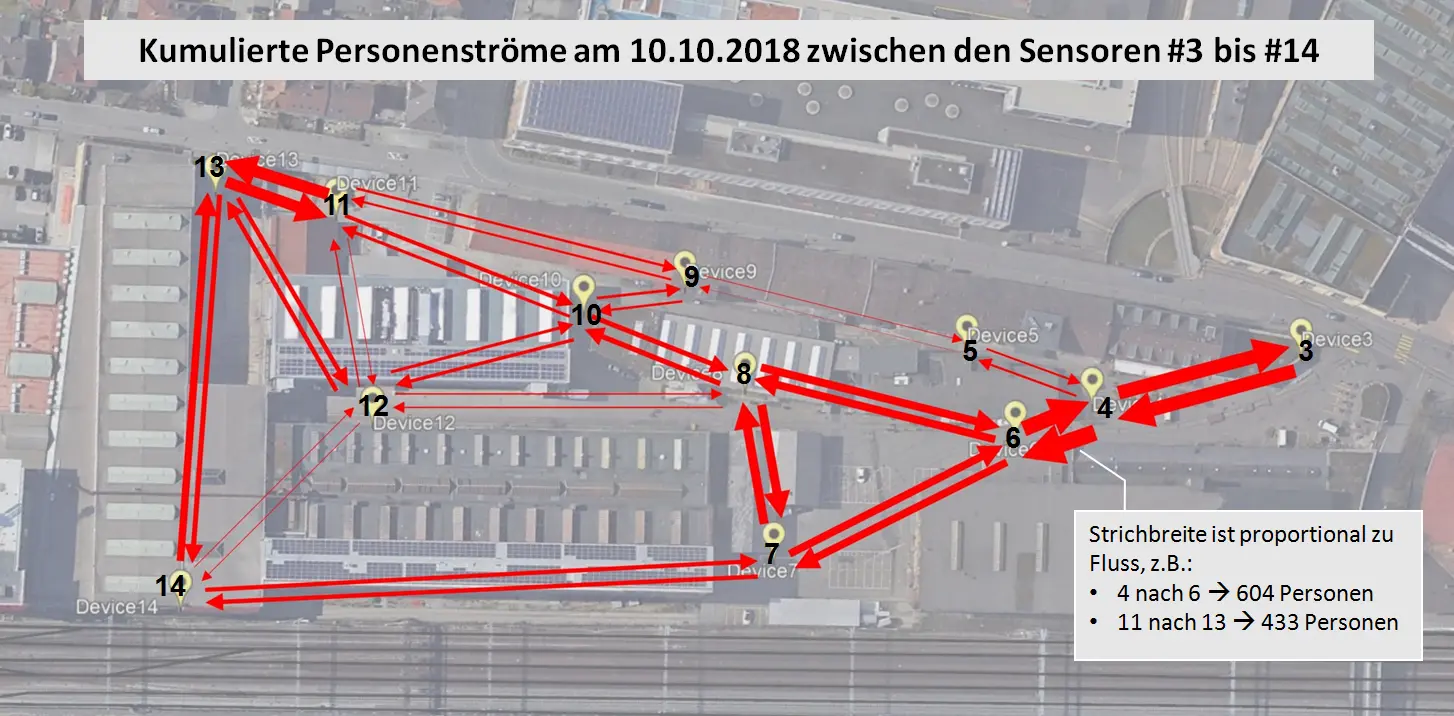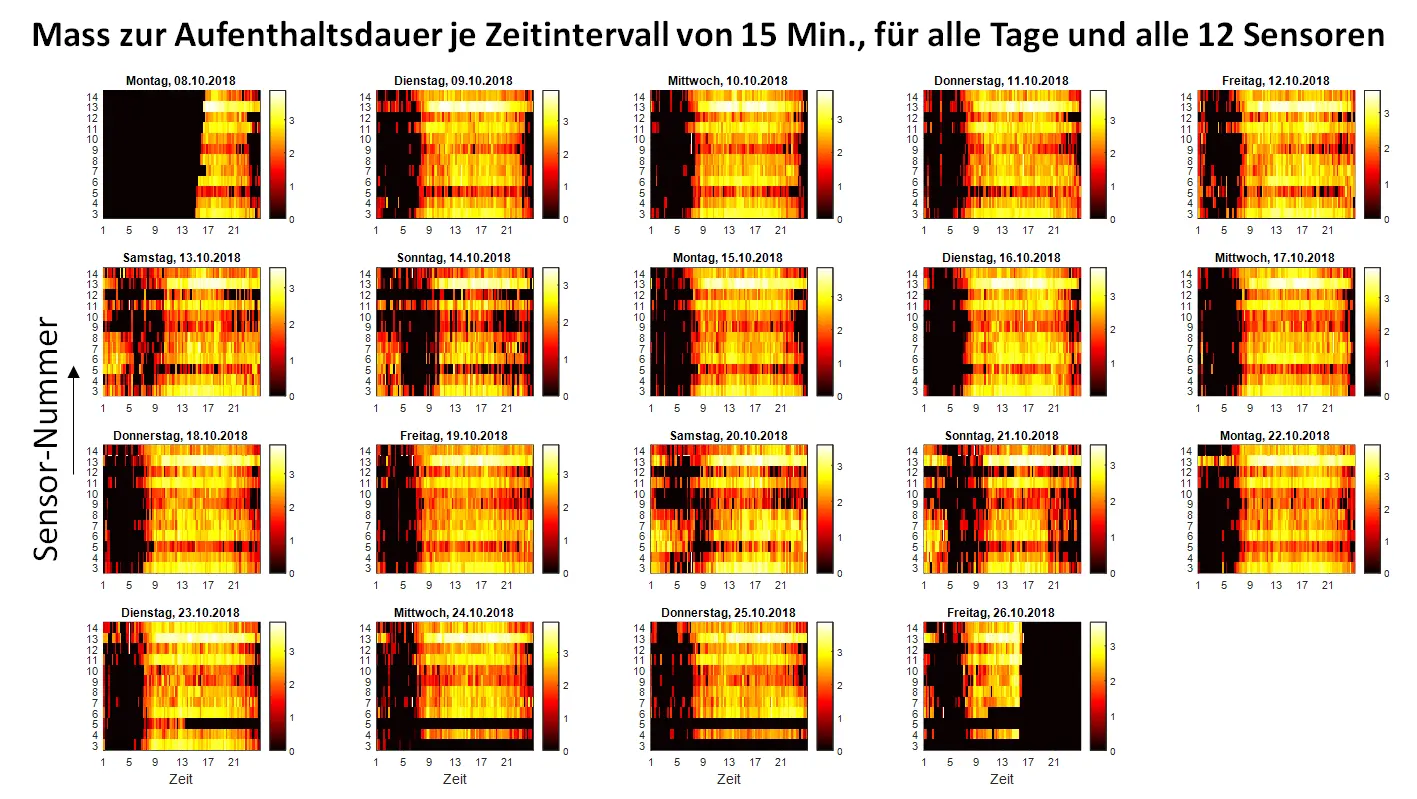Detection and analysis of the flows of people in public spaces by means of anonymous Bluetooth tracing
The detection and analysis of the flow of people provides important insights into the spatio-temporal behaviour patterns of people in public spaces such as city parks, shopping facilities, or railway stations.
The project "Public Space: Figurations of the Public Sphere and their Contribution to Social Integration", led by the ZHAW Institute Urban Landscape, was funded by the ZHAW as part of its research focus on social integration.
With growing populations and the accompanying development pressure, public space is (once again) getting special attention in the public and in political debates. Awareness is slowly growing that public space can or must make a significant contribution to societies with high diversity. The central thesis is that the interaction between space and people in public space is a basic building block for the integration of people into society - and accordingly, depending on the figuration (according to Norbert Elias: dynamic social network, network of relationships) of the public sphere, it has an integrating effect. Accordingly, the question arises as to which figurations of the public sphere (local-specific spatial-societal constellations for the integration of people into society) have what potential for social integration nowadays. Findings from contexts, effects, dependencies, and specifics should provide planners with indications of how sustainable and integrative spaces can be designed. (Project summary IUL)
The focus of the research is on the interaction of spatial offers/structures and human actions, which are to be described and discussed in terms of their integration potential. The following four public spaces in Switzerland will be studied as case studies: (1) Lagerplatz, Winterthur, (2) Murg-Auen Park, Frauenfeld, (3) Richtiplatz, Wallisellen, (4) Europaplatz, Bern.

Tracing the interactions between people and space is complex. Accordingly, they cannot be captured with a single method. The methods listed below were applied to the case studies (details on the individual methods will be published in the final report of the project) each covering a specific spectrum of the field of investigation of the interaction between space and society. They complement each other or can also contradict each other: (1) systematic media investigation, (2) static snapshot, (3) space syntax, (4) image analysis on social media, (5) measurement of people flows via anonymous Bluetooth tracing, (6) photography, (7) virtual reality and drone footage, (8) threshold spaces.

In the sub-project "People flow measurement via Bluetooth", which was performed jointly by the ZHAW Institute for Signal Processing and Wireless Communications (ISC) and the Institute for Data Analysis and Process Design (IDP), the aim was to record people flows in public spaces and to determine spatio-temporal patterns for the use of these spaces.
To record the flows of people, the ISC developed around twenty so-called Bluetooth readers. These are devices with which Bluetooth-capable smartphones, notebooks, or headsets (with activated Bluetooth interface) can be detected. Several time stamps were recorded for each detection, e.g., the earliest and latest time of a detection to determine the duration of stay of the device. Furthermore, the signal strength and other variables were stored for subsequent analyses. In terms of data protection, Bluetooth has a decisive advantage: since only the ID of the device chip (the so-called MAC address) is recorded, only the device chip can be identified, but not the owner of the device. Accordingly, the procedure can be considered anonymous in terms of personal identification.
Starting in November 2018, a series of measurements were carried out: three times during two weeks at each of the four locations. The main objective was to record the flows of people between the Bluetooth readers and to determine the duration of stay per recording location. The flows were determined by recognising the device ID and by providing information about where and when people move in the study area. The duration of stay, on the other hand, tells us something about when and for how long people were staying in the area around a recording location. Depending on the time interval over which the numbers were aggregated, different insights into the people dynamics in the system could be gained.
The collected sensor data was analysed in detail at the IDP to allow for making statements about the flow of people (see figure 1) and the duration of stay (see figure 2). The discussion of results with the IUL and ISC team showed that the results were plausible and in agreement with other analyses already carried out.